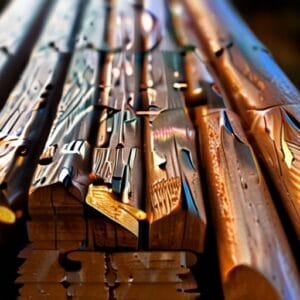Hey everyone! We all know how enjoyable it is to gather around a fire on a cold evening, right? Let me tell you about a type of wood that can make this experience even better: Pinion wood. This article will not only explain the characteristics of this wood but also highlight its benefits from a carpenter’s perspective. By the time you finish reading, you might be eager to use this special wood for your next campfire.
Characteristics of Pinion Wood
Pinion wood is a popular firewood for outdoor fireplaces and chimineas. Although it is technically classified as a softwood, it is harder, denser, and has a higher BTU (British Thermal Unit) than most softwoods, earning it the nickname “the hardwood of softwoods.”
One of the main reasons for its popularity is the pleasant pine aroma it releases when burned. The scent, whether the wood is burning or not, gives people a feeling of being outdoors. Additionally, it burns cleanly, is easy to ignite, produces plenty of heat, burns for a long time, and generates little ash. It’s also claimed to repel mosquitoes when burned, with some people using it specifically for this purpose to keep bugs away.

Where Does Pinion Wood Grow?
Pinion wood comes from the pinyon pine tree, also known as piñon or pinion. These trees grow in the dry regions of Mexico and the southwestern United States, particularly in the high mountains of the Colorado Plateau in New Mexico and Arizona. They tend to grow in areas too dry for ponderosa pine and are often found mixed with juniper trees.
Ecological and Cultural Significance of Pinion Wood
Pinyon pine is a small, slow-growing tree, usually reaching only 10-30 feet in height. Its seeds are edible and important for wildlife. Native Americans used pinyon pine nuts as a staple food, and today, these nuts are considered a delicacy by many. The pine nuts you buy in stores typically come from pinyon pine trees.
Carpenter’s Perspective on Pinion Wood
Pinion wood is not just valuable as firewood; it offers several benefits to carpenters as well. Its hard and dense nature makes it ideal for creating durable furniture and decorative items. Additionally, the characteristic scent of this wood creates a pleasant working environment. Most carpenters appreciate its workability and the aesthetic value of the finished products.
Uses of Pinion Wood
- Outdoor Fireplaces and Chimineas: Pinion wood is excellent for outdoor fireplaces and chimineas. Its high BTU value ensures it provides plenty of heat and burns for a long time.
- Insect Repellent: Pinion wood can be used as a natural insect repellent when burned, keeping mosquitoes and other bugs at bay.
- Carpentry: Its hard and dense structure makes it suitable for furniture making, and its pleasant aroma creates a delightful working environment.
- Food: The seeds of the pinyon pine, known as pine nuts, are both nutritious and delicious.
Differences Between Pinion Wood and Other Firewoods
Compared to other common firewoods, pinion wood offers several advantages. For example, hardwoods like oak have high BTU values but do not provide the pleasant aroma or insect-repelling properties of pinion wood. Softwoods generally have lower BTU values and do not burn as long as pinion wood.
Conclusion
In conclusion, pinion wood is an ideal firewood for outdoor fireplaces and also a valuable material for carpenters. Its pleasant aroma, high heat output, and long burn time set it apart from other firewoods. Additionally, its insect-repelling property and nutritious pine nuts contribute to its ecological and cultural significance.
In this article, we explored the characteristics of pinion wood, its growing regions, ecological and cultural importance, benefits from a carpenter’s perspective, and its comparison with other firewoods. I hope this information is helpful and that you consider using pinion wood for your next fire.
